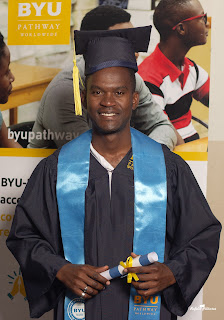The role of disruptive technologies in higher education | Tatenda Felix Mukaro
Tatenda Felix Mukaro
Sister Elisabeth Thomas
Eng 150
28 June 2021
The role of disruptive technologies in higher education - Part 1
Over the years, the state of higher education has gradually evolved in what now seems like a downward slope if no action is taken. An argument has for quite some time been raised on its role and relevance to the modern-day student who is faced with different dynamics and obstacles on their hands. According to Kate Catterall, Julia Mickenberg, and Richard Reddick, “As universities become increasingly privatized, siloed, and entrepreneurial; as academic labor becomes more contingent; as public funding for universities diminishes even as costs rise; and as “success” is increasingly measured by graduates’ salaries and grant funding yardsticks that call the value of the arts and humanities into question.” Such a change as this needed in higher education can be cascaded by the implementation of disruptive technologies leveraged by a design thinking and innovative mindset.
Disruption, as it pertains to higher education, is best described as the use of modern technology in its pedagogy. Disruptive technologies have been a force to reckon with in the advancement of most twenty-first-century disciplines. It has also been greatly catalyzed by related innovations and design thinking mindsets. In the research done, many argue that the future of most conventional institutions is blurry if they do not embrace the disruptive nature of higher education and will become absolute if they do not do so.
Others argue on the symbiotic nature of both learning modes. I wish to explore both viewpoints and come up with the best argument on disruption in higher education. Kate Catterall and her team further argue that “But like “innovation” itself, in recent years design thinking has been co-opted to serve corporate models of higher education.” In the past, education itself has been a privilege for the elite only and those capable of affording it. Disruption in higher education has been effected to disrupt that trend and create opportunities for a new market that was before not served by the conventional higher education institutions. This will in turn create a sustainable ecosystem for the learner and also the respective learning institution. Leveraging technology and education is in other words definitive of the disruptive nature of technology in higher education.
Leveraging technology and education is made possible by harnessing the symbiotic relationship between research done in technology and also in the pedagogy of higher education. Advancements in technology include but are not limited to the worldwide coverage and access to the internet, cloud technologies, access to learning devices, and learning softwares. Leveraging such technologies have also supported the development of newer and modern curriculums which have been a sum-total of the whole image of disruptive innovations as they are to higher education today. This connection between disruptive technologies and higher education is quite evident in the way BYU Pathway Worldwide has evolved over the past decade. President Clark Gilbert of the BYU Pathway Worldwide highlighted the local context their institution has on a local level, he says “So it’s not just the online piece, but it’s also the community into which you get acclimated and plugged into as a learner. That becomes an incredible support structure for you.” With this concept in mind, the conventional campus becomes scalable as a global campus, with all the supporting resources available to the campus student being made available to the global student. Another set of lenses is further highlighted on how the disruptive nature of such technologies is manyfold.
The role of disruptive technologies is thus imperative to the pedagogical development of the future of higher education and the development of socio-economic opportunities for many. This standpoint is however still arguable by many.
Relevance of innovation in Higher Education - Part 2
As earlier scholars have highlighted and suggested a certain relevance of such an innovation in higher education, a standpoint is inarguably farfetched at this juncture as the odds are quite twofold. According to the book, “Disrupting College - How Disruptive Innovation Can Deliver Quality and Affordability to Postsecondary Education” , Clayton M. Christensen, Michael B. Horn, Louis Caldera, Louis Soares suggest a positive notion to this topic. They argue that in reality disruption as the word itself suggests is there to disrupt the conventional college and mode of learning. Such a disruption they suggest is evident in today's college system and has alleged it to deliver a quality and affordable education to many. One might then ask themselves what new opportunities are there in higher education and how sustainable are they. Is such a transition affordable and flexible? Some if not most of these questions have been discussed quite extensively in the “Disrupting College”.
The authors begin by describing a shift in higher education exemplified by the American College System. America is deemed to be facing, just like most parts of the world, the highest unemployment rates in any generation, and yet there remains a deficit of qualified people to hire. America has also always supported the expansion and access of higher education to people. Some ways they have done this is through mechanisms such as Pell Grants, student loans, and subsidies. These mechanisms have served their time and can only do as much whilst it becomes quite evident of them reaching the limits today. A reflective thought is then highlighted by the author, “We can’t get to where we need to go from where we have been.” A concise solution is suggested and evident in what they describe as the rise of a new educational model. Their standpoint is biased towards the relevance of disruption in higher education as a solution towards this crisis being faced by a mechanism that once worked but has reached its limits in the American college system and the world at large.
With the conventional system having baled out a few in the past. Issues to do affordability and quality will be unlocked by such a disruption as defined in higher education. Access will also be enhanced by the advancements which have happened in technology. Technology will then become an enabler of the vision realized in higher education's future. In a nutshell according to the book “Disruptive Innovation”, “Disruption occurs in industries where there is an enabling technology that can scale upward and allow the disruptive entrants to take their low-cost business models up-market. Higher education has not had an upwardly scalable technology driver up until this point. This seems to be a point of reference to relevance in today's modern society.
Challenges and Irrelevance of Technology in Higher Education
“The Application of Distributed Information Systems Based on Blockchain Technologies in Higher Education: Benefits and Challenges for Ukraine” is a detailed research done by Oleh A. Zaiarnyi and Inna S. Zaiarna of the faculty of Law at the University of Kyiv, Ukraine. This research pins out a unique example of a disruptive innovation called blockchain and highlights some of its risks and challenges. The complexity of software development capable to fully
combine properties of already existing technologies with blockchain technologies is imminent.
Firstly, the implementation of blockchain requires time and effort due to social, technological, and economic reasons. Secondly, these technologies face challenges in areas such as privacy, transparency, functionality, and value of the certifications. Scalability, ethical conduct, and quality assurance issues are also key problematic possibilities foreseen in the application of these disruptive technologies today.
The complex nature of some of these purported disruptive innovations takes ages to build and implement at the cost of today's students being used as dummy pigs in their design process. The time factor then renders it difficult to scale up a modern education for today's higher education-seeking student. Though regarded as redundant, the conventional school seems to have served us well before and continues to serve us today. Built upon values of ethical conduct, quality, and reliability, unlike the online and virtual modes. Another important viewpoint for the conventional school is the close teacher-to-student interaction and social connections enhanced by a physical campus and learning environment. The challenges evident in the deployment of the alleged disruptive innovations are in actual sense a disruption to an already functioning system, a negative disruption in this context.
In the case of the Ukraine research, they have garnered great research and information and the challenge then comes with implementing and sustaining those ideas. This will cost them time and money. It then seems to be a reality that these challenges which were also identified as part of this research support the idea of the irrelevance of the disruptive innovations of technologies in higher education. It seems to be an artificial relevance targeted at creating newer avenues of collecting user information and data.
Future of Technology in the classroom - The Cons
Another interesting viewpoint raised on disruptive innovation in higher education is by Keith Miller , “22 Advantages and Disadvantages of Technology in Education”. His article highlights a similar twofold argument on the pros and cons of Technology in Higher Education. Disconnection from the classroom. Unreliable sources, medical problems, time management issues, and technology is a resource that not all families can afford are the most common cons. In the long run, medical challenges arise with the excessive use of technology to the eyes and the backs, due to increased screen time and also sitting positions. One other component which many have experienced is the challenges to do with time management.
A most recent first-hand experience I had on the unreliability of technology in education is when I was scheduled to have my student teacher conference for my Writing and Reasoning class. The technology failed me as I was to do a one to one synchronous meeting with my instructor and it failed due to technological or network problems.
Keith Miller's article seems to provide a neutral argument on this topic and is biased towards a neutral standpoint. It is thus imperative eventually to come up with a concise and strong argument on which viewpoint seems valid and quite convincing.
The vantage point of Disruption in Higher Education ( Part 3)
Disruptive innovation has a great reason for being, in the power of thinking
through the challenges and changes confronting higher education. Many of the challenges
which have been before investigated in-depth are but a wake-up call on the need to harness and
implement such disruptive innovations for the betterment of our communities. Such a change
as this needed in higher education cascaded by the implementation of disruptive technologies
can also be leveraged by a design thinking and innovative mindset. It is thus imperative to
articulate a comprehensive view on the vantage point of Disruption in Higher Education.
In the book Disrupting College, Clayton M. Christensen, Michael B. Horn, Louis Soares, and Louis Caldera highlight that, “Disruptive innovation is the process by which a sector that has previously served only a limited few because its products and services were complicated, expensive, and inaccessible, is transformed into one whose products and services are simple,
affordable, and convenient and serves many no matter their wealth or expertise.” The book explores the various advantages associated with the use of these disruptive innovations in higher education. Challenges being faced in the conventional higher education systems can to a greater extent be solved by these innovations and are a basis for a need for a paradigm shift as such. Disruption in this instance is solving the challenge of lack of access to education, affordability, flexibility, and the creation of an array of opportunities for the future world.
One very notable disruption, disruptive innovations have done is to bring to pass access to many with whom education had before not been a reality. Majoni Cuthbert, in the book “Challenges Facing University Education in Zimbabwe”, highlights the challenges which have been solved by technology. He states “ Fees are too high and most students cannot afford to study with universities, especially from a poor background. University education has become a preserve of the elite. Very few students are able to pay for fees hence the inability to attract viable classes. Student accommodation fees are also high and students are deferred from joining universities. There is restricted entry to university education barring those with fewer A' level points. Adult students are sacrificing their studies so that their children access university education.” Because of the advent of innovations thinking mindsets and disruptive technologies most if not some of the issues are becoming absolute. Access is becoming more of a reality with different pathways to higher education is made available. One such example of an institution providing alternative access to higher education is BYU Pathway Worldwide.
A second notable disruption happening in higher education is evident in BYU Pathway Worldwide. Their program is a product of design thinking coupled with these disruptive technologies in higher education. As a result of this design thinking, they are solving the challenge of affordability . Other universities have taken a more targeted approach to growing specific nontraditional markets. In the Stanford Social Review, “Design Thinking for Higher Education”, President Clark Gilbert states that, “BYU-PW began with a focus on reaching students who were not being served by the existing BYU system because they did not feel that they could afford college or because, in some cases, they did not feel that they could succeed.” Their program is very much affordable and is a huge disruption in cost. Their cost per credit hour varies based on each country and in the USA 1 credit hour costs about 80 USD as compared to about 600USD per credit hour in normal conventional institutions. The cost has been disrupted immensely due to the advancement of technology and will continue to do so in the near future.
A third and important disruption also happening in higher education is that of flexibility. In the Stanford Review, Clark Gilbert stated also, “Other universities have taken a more targeted approach to growing specific nontraditional markets. For BYU-Pathway, this began with a focus on reaching students who were not being served by the existing BYU system. Similarly, BYU-Idaho’s online degree programs start with certificates and associate degrees, rather than
maintaining the almost exclusive focus on bachelor’s degrees at more traditional universities.” This has allowed many students to advance more quickly in the workforce and access a more applied curriculum than a traditional campus-centric model of higher education would do. This flexibility in learning is an example of disruption. A student of all ages can enroll to study and gain skills as they work towards their bachelor’s degree. This allows them to work, have families and gain a higher quality education at the same time. This is not possible with an old conventional system.
The three disruptions which have just been highlighted are but a few of the many disruptions which have happened in higher education due to the advent of design thinking and the advancement of technology. It is thus quite evident that most challenges being faced in the world due to lack of educated and skilled labor can be circumvented by a conscious adoption of these disruptive technologies in higher education. It is relevant and as such most institutions will become irrelevant if they remain complacent or conservative in their approach.
Works Cited
“Access and Affordability in Higher Education” by Gale, a Cengage Company“Design
Thinking, Collaborative Innovation, and Neoliberal Disappointment: Cruel Optimism in the History and Future of Higher Education” by Kate Catterall, Julia Mickenberg and Richard Reddick
Walch, Tad. “How BYU-Pathway Worldwide Is Disrupting Higher Education.” Deseret News,
20.Aug.2019,www.deseret.com/indepth/2019/8/19/20812530/byu-pathway-worldwide-disrupt-higher-education.[Accessed May 2021].
Miller, K., 2021. 22 Advantages and Disadvantages of Technology in Education. [online]
FutureofWorking.com. Available at: <https://futureofworking.com/10-advantages-and-disadvantages-of-technology-in-education/> [Accessed 8 June 2021].
Zaiarnyi, Oleh A., and Inna S. Zaiarna. “The Application of Distributed Information Systems
Based on Blockchain Technologies in Higher Education: Benefits and Challenges for Ukraine.” 2019 IEEE International Conference on Advanced Trends in Information Theory (ATIT), Advanced Trends in Information Theory (ATIT), 2019 IEEE International Conference On, Dec. 2019, pp. 340–343. EBSCOhost, doi:10.1109/ATIT49449.2019.9030456.
“Disrupting College.” Center for American Progress, 8 Feb. 2011,
www.americanprogress.org/issues/economy/reports/2011/02/08/9034/disrupting-college.[Accessed 8 June 2021].
Majoni, Cuthbert. (2014). Challenges Facing University Education in Zimbabwe.
Greener Journal of Education and Training Studies. 2. 020-024.
10.15580/GJETS.2014.1.021714111.[Research Gate - 21 June 2021]
____________________________________________________________________________





Comments
Post a Comment